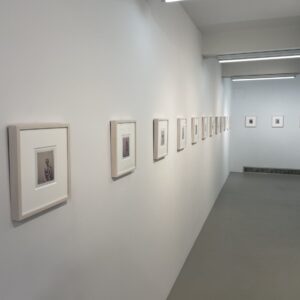JTF (just the facts): Published by Meteoro Editions in 2019 (here). Hardcover, 104 pages, with 55 black and white photographs. Includes texts by Anna Lee and Leah Ollman. In an edition of 500 copies. (Cover and spread shots below.)
Comments/Context: Vernacular photography, the most ordinary or utilitarian form of photographic imagery, has long been overlooked and underappreciated. But in recent years, these pictures have attracted more interest – as social history, as rediscovered artworks, as collectibles, and as cultural artifacts. Peter J. Cohen, a New York-based collector of snapshots and vernacular photographs, has been collecting vernacular imagery for over 40 years. Cohen’s archive includes some 60,000 photographs, organized into 130 categories. He has generously donated portions of his collection to various museums, including the Metropolitan Museum of Art, MoMA, MFA Boston, the Art Institute of Chicago, the Morgan Library, and SFMOMA (among others), encouraging these institutions to not only exhibit the works, but also to expand their own collections of vernacular images.
Over the years, a number of photobooks have been published using photographs from Cohen’s collection in one way or another. The most recent example is by Yael Eban, a Brooklyn-based visual artist, who has been working with Cohen for a number of years. Her efforts have focused on organizing Cohen’s archive into unique and often unexpected categories and groupings – bush, one leg, me, birthday cake, people organized neatly, double exposure, paper moon, to name just a few – and working with the archive inspired Eban to start her own project looking at photographs related to lighthouses. False Lighthouse has recently been published by Meteoro Editions, an independent publisher with a focus on projects that “deal with vernacular photography, archives, utopias and fictional representations of the world.”
False Lighthouse has a dark grey cover with the title placed in the upper right corner, like a faraway vision. The book has an elegant endpaper, in light sugar green with a compass pattern; the text in the middle of the book is printed on the same paper, creating a visual conversation between the elements. The title of the book, False Lighthouse, is explained as “a false coastal light (or the extinction of a light) which lures ships onto rocky shores.” According to some nautical stories and legends, pirates used lights to attract ships toward the coast, deliberately causing wrecks so that they could plunder them. However, there is no actual evidence of this; in fact, the presence of lights usually signals to the ships to stay away. Yet, as a myth, and all nuances aside, it is a captivating idea and a beautifully evocative title.
Eban’s selections from Cohen’s extensive collection include literal photos of lighthouses, as well as more figurative and abstract connections to her fable. And rather than reproducing the photographs as they are (keeping the actual sizes, proportions, and borders), Eban uses her artistic vision to edit and sequence the images into a open-ended and mysterious flow.
In general, a lighthouse serves as a navigational reference and warns ships of hazardous areas, thereby symbolizing motifs like guidance, hope, and direction. But Eban’s photobook quietly upends that sense of support. The book opens with a small horizontal image depicting a lighthouse in the distance, with sandy hills covered with snow in the forefront framing its faraway beacon from the vantage point of the land. What follows is a gradual pulling back and removal of certainty, from paired coastlines and a shadowy grotto-like opening, to telescoped views of boats and increasingly foggy skies. The first half of the book ultimately ends with puzzling splashes, menacingly rocky cliffs, and disorienting flares of the sun, creating a sense of suspense. Eban often places one or two images per spread, mixing full bleed images that draw us in with framed images that pull back out.
The text in the middle divides the book, shifting the visual narrative. Most of the photographs in the second half are full bleed, and many are balanced by black pages and dark colors. Eban also focuses more on the physicality of the photographs, allowing the scratches, folds, and even pieces of dust to show. This attention to these details, that are in a sense unique to vernacular images, reminds us that these images were brought from private to public, and reinforces our feeling of historical authenticity. The photographs themselves test our sense of clarity, pulling us down a serpentine staircase, blurring a rising moon, forcing us to squint into the sun, and offering us ghosts of ships and shoreline widows. The last photograph in the book is a negative of the very first image in the book, this time placed against the black background (its texture shows pieces of dust and paper wrinkles), making us wonder if it was all an inversion or delusion.
In False Lighthouse, Eban has done more than dig into the archive and come out with a bunch of pictures of her chosen subject matter. Acting both as an archivist and an artist, she explores the possibilities embedded in these vernacular images, extending them into a seductively lyrical meditation.
Collector’s POV: Yael Eban does not appear to have consistent gallery representation at this time. As a result, interested collectors should likely follow up directly with the artist via her website (linked in the sidebar).
























